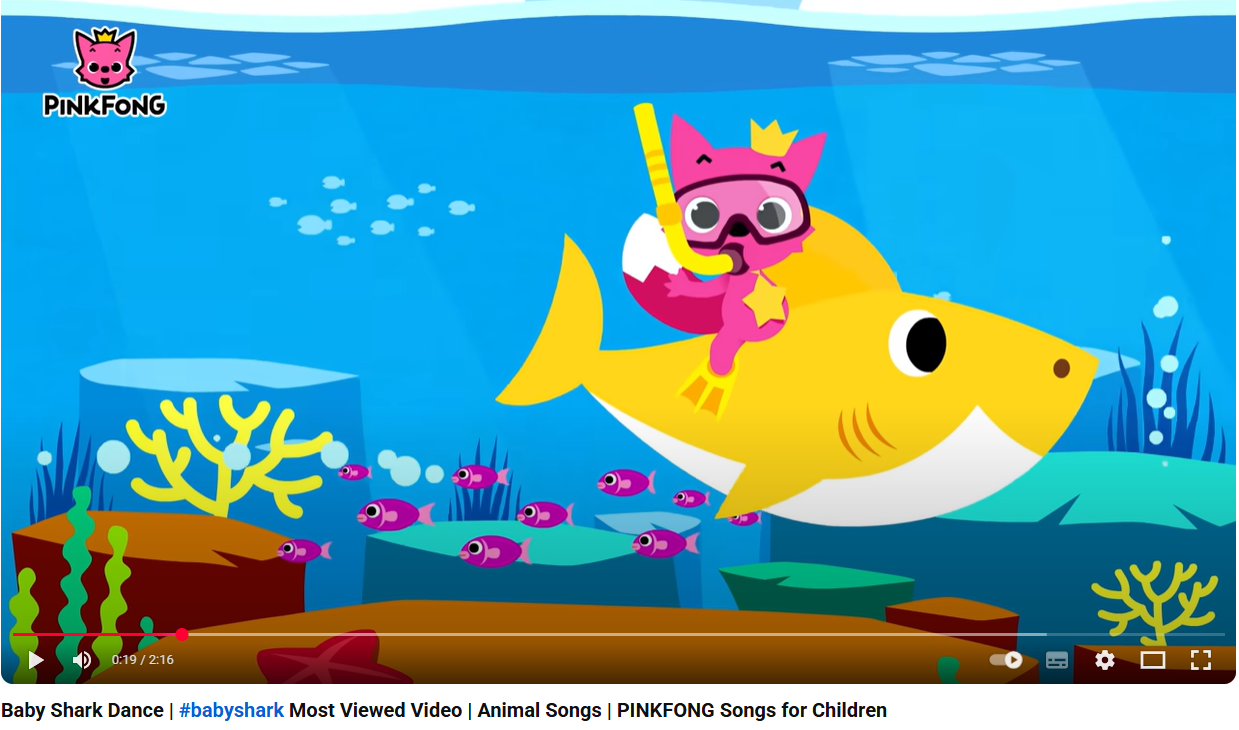As of 2025, the most viewed YouTube video in history is “Baby Shark Dance” by Pinkfong. It has surpassed 16 billion views, making it the first and only video to reach such a staggering number. What began as a simple children’s song has evolved into a global cultural phenomenon. Unlike the typical viral hit that fades with time, “Baby Shark Dance” has proven its endurance by maintaining steady growth for years.
Part of its success lies in its universal design. The lyrics are simple and repetitive, the melody is addictive, and the visuals are bright and engaging for young viewers. This makes it ideal for children, who are among the most loyal repeat viewers on YouTube. Many parents let the song play multiple times, sometimes in the background, boosting its numbers in a natural, organic way.

There are several reasons this song became more than just a trend. First, it appeals to a global audience without needing translation. Anyone, regardless of age or language, can understand and hum along with “doo doo doo.” That accessibility gave it a reach few songs can match.
Second, children’s content benefits from a unique algorithmic advantage. YouTube prioritizes videos that keep viewers engaged and encourage replays. Because “Baby Shark Dance” consistently achieves high retention and repeat play, it is frequently promoted in YouTube’s recommendation system, multiplying its visibility.
Third, the video became part of a much larger franchise. Pinkfong expanded the brand through toys, books, television shows, and even live performances. Each new format kept the original song alive, sending new waves of viewers back to YouTube. Over time, billions watched, and many even downloaded the YouTube video to keep it playing offline, turning one short clip into a long-term entertainment brand.
Before “Baby Shark Dance” claimed the crown, the title of most viewed YouTube video changed hands many times. In earlier years, amateur viral clips like “Charlie Bit My Finger” and “Evolution of Dance” dominated the charts. Their charm came from authenticity: simple, funny moments that resonated with millions.
Then, music videos took over. When Psy’s Gangnam Style broke the billion-view barrier in 2012, it showed the world that YouTube could rival television as a stage for global hits. Later, songs like See You Again by Wiz Khalifa and Despacito by Luis Fonsi pushed those limits further, proving that international music could unite audiences across cultures.
Today, those massive hits remain iconic, but none can match the sheer rewatch value of a song loved by children. Despacito still ranks second with billions of views, but its pace of growth has slowed while Baby Shark continues to climb. The shift from adult-oriented music to children’s entertainment at the top of the list reflects a deeper trend in how audiences use YouTube, not just to discover but to repeat, comfort, and engage.
The story of “Baby Shark Dance” is more than a record-breaking tale. It shows how modern virality depends on three key elements: emotional simplicity, cultural neutrality, and algorithmic strength.
Emotional simplicity means the content delivers joy or comfort instantly, without needing explanation. The song achieves this through rhythm and repetition. It requires no context to enjoy: anyone can watch and smile.
Cultural neutrality ensures it travels across borders. There are no complex lyrics, jokes, or references that only one group understands. That neutrality transforms a regional children’s song into a global anthem.
Algorithmic strength comes from watch time and retention. Because children rarely skip or pause videos, YouTube’s system identifies them as highly engaging, recommending them again and again.
These three traits create a perfect storm: content that feels familiar, requires no translation, and keeps people watching.
Beyond its numbers, “Baby Shark Dance” has reshaped how we view YouTube’s influence on early childhood entertainment. It blurred the lines between education, fun, and global culture. For some, it’s a catchy tune; for others, a tool to calm toddlers or teach rhythm. Its omnipresence shows how digital media has become part of family routines worldwide.
It also set new expectations for content longevity. Unlike most viral videos that peak and disappear, “Baby Shark” remains relevant years after its release. Its durability shows that true virality doesn’t always depend on novelty; sometimes, it depends on familiarity.
At the same time, its dominance has sparked discussions about balance in screen time and children’s exposure to repetitive digital media. Parents and educators continue to debate how platforms like YouTube should handle such content responsibly. Still, it’s hard to deny the cultural footprint this song has left behind.
As of 2025, “Baby Shark Dance” by Pinkfong holds the record with over 16 billion views.
It’s repetitive, catchy, and universally understandable, making it ideal for children who watch it multiple times daily.
Despacito, Wheels on the Bus, and See You Again are among the top contenders, all with billions of views.
Yes, as long as it’s a genuine play by a user and not flagged as spam or automated traffic.
It’s possible but difficult. It would need massive global appeal and rewatch value similar to children’s content.
Focus on engagement and retention, create content that transcends language, and aim for timeless simplicity over short-term hype.